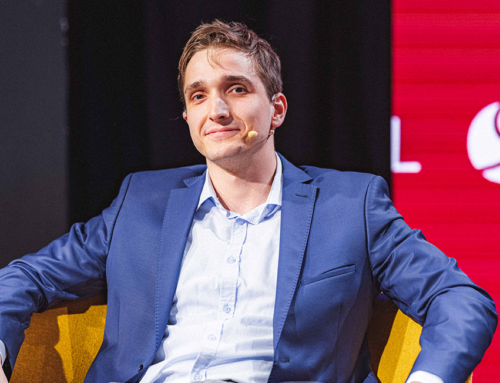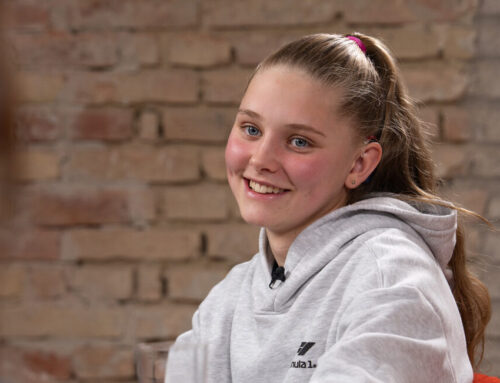A good experience with a cochlear implant
Brigitte is so satisfied with her cochlear implant that she now wants one for her other ear. It was not always like this.

On her veranda, Brigitte is talking to a friend on the phone. The connection in the house is poor and her friend would have problems to understand her. Brigitte does not have such problems, although she has suffered from hearing loss since her early childhood. Without her hearing device, though, she would hear almost nothing. But thanks to her cochlear implant, even using the telephone is not a big deal.
The road to talking on the phone was a long and windy one for Brigitte, who works in the administration of a hospital in Vienna. She received her first hearing aid when she was eight years old. Although her hearing was poor in both ears, she only received one device back then. She finished school, met her husband, got married, had her children – all with a hearing aid. This changed at the turn of the millennium.
Not my life
Brigitte’s hearing decreased progressively until she became functionally deaf around 40. Her family and friends accepted her hearing loss, but “no matter what, whether I had to make a phone call or see a doctor, I was always depending on my husband.” She is still grateful for his endless support, but felt that depending so much on him in everyday life “just wasn’t my life.” The mother of two looked for alternatives. She knew sign language from her adult son who, back in the 1980s, had been diagnosed as profoundly hearing impaired in preschool and had started learning sign language. Some years later both Brigitte and her husband learned sign language, too. Brigitte laughs out loud looking back: “I strongly opposed cochlear implants.” Over time, however, she became doubtful: “The Sign Language Community lives in a world of their own. But me and my husband mainly lived in the hearing world.”
A visit to the doctor was one of several turning points. “I told staff members that I couldn’t hear and asked them to face me when speaking. Neither the assistant nor the doctor managed to do that.”
After long and careful consideration Brigitte eventually decided to get a cochlear implant. She was implanted in 2011, at the age of 46 years. The success exceeded her expectations. “After two months I was able to understand perfectly well!” She seemed to have arrived at her final hearing destination.
Safe cochlear implant, safe surgery
Soon after Brigitte received her CI, her implant manufacturer had a product recall due to repeated failures. “I read about it in the newspaper and said to my husband: “I hope my implant isn’t from this batch.” Her hopes were crushed and she had to undergo another surgery in February 2012. She was reimplanted with an older generation implant. New problems occurred a year later: the wound started oozing and a tiny hole appeared over the implant site.
The ENT clinic wanted to reimplant again, but Brigitte had lost faith in both this clinic and the implant manufacturer. “I was crying my eyes out”. She consulted another hospital. The Chief ENT Physician could not do anything else but to remove the implant again. Apparently, it had not been secured tightly enough in her head. Tiny movements may have led to the skin irritations. The experienced surgeon offered to implant Brigitte’s right side, as the left one would need time for healing. “But after my previous experience I was hesitant.” However, now in her mid-fifties, the active woman did not want to accept for good the lack of independence that came with being deaf in a hearing world. It took Brigitte two years to pluck up her courage for yet another implantation. Wolfgang Gstöttner, the experienced surgeon at the Vienna General Hospital, eventually decided to implant the left ear, as it had healed in the meantime. “He explained in detail that he would fix the implant with sutures, bone and a special glue.” Combined with fixation pins Brigitte’s SYNCHRONY implant is now secured four-fold against movement. Ever since, Brigitte has been hearing perfectly well and hassle-free.
The things that really count
“You cannot imagine how happy I was when I heard my cat meow for the first time with my new CI”, Brigitte recalls enthusiastically. “And hearing the birds singing in the garden”. She continues with a mischievous smile: “I even hear my husband grumble behind me.” Hearing with a CI is not like natural hearing, just like seeing with glasses is not exactly the same. Brigitte is aware of the challenges: Talking on the telephone requires concentration, conversations on the TV are sometimes hard to understand when there is background noise. But: “I even go to the theatre and opera again.”

Brigitte is now able to go to the theatre and opera again
For Brigitte, good technical support is as important for long-term hearing success as the implant itself. She still feels disappointed about her first two implants. “This manufacturer did not offer any support when I needed it most.” She praises MED-EL’s service and the commitment of their clinical engineers. “On the first day of Covid-19 lockdown, I broke something on my processor.” She called the service hotline and they told her to pop by. “I handed my processor through the glass opening and five minutes later they handed the mended processor back to me.”
“I can only recommend everybody who needs a CI to go and get one.” Brigitte is now waiting for an appointment to implant her second side. “Life is easier with two ears”, she is convinced. “This time I’m going for MED-EL right away!” The means of communication is every person’s individual decision. “For children”, Brigitte says, “it’s important to keep all options open. Children should be given this chance, because our world is mainly made up of hearing people.”






